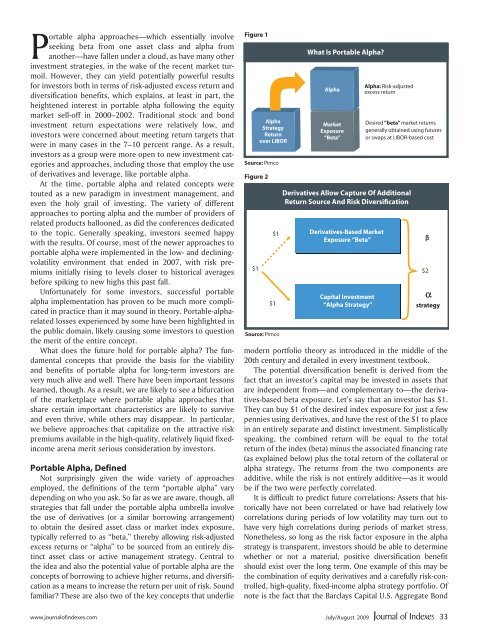How to Kill a Black Swan Remy Briand and David Owyong ...
How to Kill a Black Swan Remy Briand and David Owyong ...
How to Kill a Black Swan Remy Briand and David Owyong ...
Create successful ePaper yourself
Turn your PDF publications into a flip-book with our unique Google optimized e-Paper software.
Portable alpha approaches—which essentially involve<br />
seeking beta from one asset class <strong>and</strong> alpha from<br />
another—have fallen under a cloud, as have many other<br />
investment strategies, in the wake of the recent market turmoil.<br />
<strong>How</strong>ever, they can yield potentially powerful results<br />
for inves<strong>to</strong>rs both in terms of risk-adjusted excess return <strong>and</strong><br />
diversification benefits, which explains, at least in part, the<br />
heightened interest in portable alpha following the equity<br />
market sell-off in 2000–2002. Traditional s<strong>to</strong>ck <strong>and</strong> bond<br />
investment return expectations were relatively low, <strong>and</strong><br />
inves<strong>to</strong>rs were concerned about meeting return targets that<br />
were in many cases in the 7–10 percent range. As a result,<br />
inves<strong>to</strong>rs as a group were more open <strong>to</strong> new investment categories<br />
<strong>and</strong> approaches, including those that employ the use<br />
of derivatives <strong>and</strong> leverage, like portable alpha.<br />
At the time, portable alpha <strong>and</strong> related concepts were<br />
<strong>to</strong>uted as a new paradigm in investment management, <strong>and</strong><br />
even the holy grail of investing. The variety of different<br />
approaches <strong>to</strong> porting alpha <strong>and</strong> the number of providers of<br />
related products ballooned, as did the conferences dedicated<br />
<strong>to</strong> the <strong>to</strong>pic. Generally speaking, inves<strong>to</strong>rs seemed happy<br />
with the results. Of course, most of the newer approaches <strong>to</strong><br />
portable alpha were implemented in the low- <strong>and</strong> decliningvolatility<br />
environment that ended in 2007, with risk premiums<br />
initially rising <strong>to</strong> levels closer <strong>to</strong> his<strong>to</strong>rical averages<br />
before spiking <strong>to</strong> new highs this past fall.<br />
Unfortunately for some inves<strong>to</strong>rs, successful portable<br />
alpha implementation has proven <strong>to</strong> be much more complicated<br />
in practice than it may sound in theory. Portable-alpharelated<br />
losses experienced by some have been highlighted in<br />
the public domain, likely causing some inves<strong>to</strong>rs <strong>to</strong> question<br />
the merit of the entire concept.<br />
What does the future hold for portable alpha? The fundamental<br />
concepts that provide the basis for the viability<br />
<strong>and</strong> benefits of portable alpha for long-term inves<strong>to</strong>rs are<br />
very much alive <strong>and</strong> well. There have been important lessons<br />
learned, though. As a result, we are likely <strong>to</strong> see a bifurcation<br />
of the marketplace where portable alpha approaches that<br />
share certain important characteristics are likely <strong>to</strong> survive<br />
<strong>and</strong> even thrive, while others may disappear. In particular,<br />
we believe approaches that capitalize on the attractive risk<br />
premiums available in the high-quality, relatively liquid fixedincome<br />
arena merit serious consideration by inves<strong>to</strong>rs.<br />
Portable Alpha, Defined<br />
Not surprisingly given the wide variety of approaches<br />
employed, the definitions of the term “portable alpha” vary<br />
depending on who you ask. So far as we are aware, though, all<br />
strategies that fall under the portable alpha umbrella involve<br />
the use of derivatives (or a similar borrowing arrangement)<br />
<strong>to</strong> obtain the desired asset class or market index exposure,<br />
typically referred <strong>to</strong> as “beta,” thereby allowing risk-adjusted<br />
excess returns or “alpha” <strong>to</strong> be sourced from an entirely distinct<br />
asset class or active management strategy. Central <strong>to</strong><br />
the idea <strong>and</strong> also the potential value of portable alpha are the<br />
concepts of borrowing <strong>to</strong> achieve higher returns, <strong>and</strong> diversification<br />
as a means <strong>to</strong> increase the return per unit of risk. Sound<br />
familiar? These are also two of the key concepts that underlie<br />
Figure 1<br />
Alpha<br />
Strategy<br />
Return<br />
over LIBOR<br />
Source: Pimco<br />
Figure 2<br />
$1<br />
$1<br />
$1<br />
Source: Pimco<br />
What Is Portable Alpha?<br />
Alpha<br />
Market<br />
Exposure<br />
“Beta”<br />
Derivatives-Based Market<br />
Exposure “Beta”<br />
Capital Investment<br />
C<br />
“Alpha Strategy”<br />
Alpha: Risk-adjusted<br />
excess return<br />
Desired “beta” market returns<br />
generally obtained using futures<br />
or swaps at LIBOR-based cost<br />
Derivatives Allow Capture Of Additional<br />
Return Source And Risk Diversification<br />
strategy<br />
modern portfolio theory as introduced in the middle of the<br />
20th century <strong>and</strong> detailed in every investment textbook.<br />
The potential diversification benefit is derived from the<br />
fact that an inves<strong>to</strong>r’s capital may be invested in assets that<br />
are independent from—<strong>and</strong> complementary <strong>to</strong>—the derivatives-based<br />
beta exposure. Let’s say that an inves<strong>to</strong>r has $1.<br />
They can buy $1 of the desired index exposure for just a few<br />
pennies using derivatives, <strong>and</strong> have the rest of the $1 <strong>to</strong> place<br />
in an entirely separate <strong>and</strong> distinct investment. Simplistically<br />
speaking, the combined return will be equal <strong>to</strong> the <strong>to</strong>tal<br />
return of the index (beta) minus the associated financing rate<br />
(as explained below) plus the <strong>to</strong>tal return of the collateral or<br />
alpha strategy. The returns from the two components are<br />
additive, while the risk is not entirely additive—as it would<br />
be if the two were perfectly correlated.<br />
It is difficult <strong>to</strong> predict future correlations: Assets that his<strong>to</strong>rically<br />
have not been correlated or have had relatively low<br />
correlations during periods of low volatility may turn out <strong>to</strong><br />
have very high correlations during periods of market stress.<br />
Nonetheless, so long as the risk fac<strong>to</strong>r exposure in the alpha<br />
strategy is transparent, inves<strong>to</strong>rs should be able <strong>to</strong> determine<br />
whether or not a material, positive diversification benefit<br />
should exist over the long term. One example of this may be<br />
the combination of equity derivatives <strong>and</strong> a carefully risk-controlled,<br />
high-quality, fixed-income alpha strategy portfolio. Of<br />
note is the fact that the Barclays Capital U.S. Aggregate Bond<br />
$2<br />
www.journalofindexes.com July/August 2009<br />
33
















